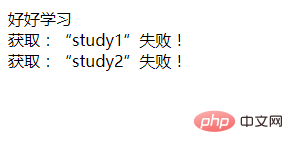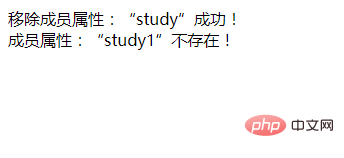
In the previous article, I brought you "Usage of clone keyword and __clone() method in PHP (detailed examples)", which gave you a detailed introduction to clone in PHP Keywords and __clone() method, this article continues to bring you the magic methods in PHP, I hope it will be helpful to you!

In our previous article, when we introduced the __clone() method, we mentioned that this is a kind of magic method. "Take you to distinguish the categories The constructors and destructors also mentioned in "Constructors and Destructors" are also called constructors and destructors, and they are also a type of magic method. So what is a magic method? What are its commonly used methods? How is it used? Let’s take a look next.
In PHP object-oriented programming, there are a series of magic methods in PHP. For these magic methods, take a look at the ones we learned before__clone\__construct\__destruct We can find one thing in common, that is, they all start with two underscores __, and they are all in a certain Automatically called under conditions.
Then let’s take a look at some commonly used magic methods and how to use them with examples.
<strong><span style="font-size: 18px;">__set()</span></strong>method
__set()The method is used to assign values to undefined or invisible class attributes in the current environment. It should be noted that all magic methods are automatically called under certain specific conditions and are used for the current The assignment of undefined or invisible class attributes in the environment is the specific condition for calling the __set() method.
The syntax format is as follows:
public function __set(要操作的变量, 要操作变量的值){
... ... ;
} The example is as follows:
<?php
class father{
public $study1;
private $study2;
public function __set($key, $value){
echo '为“'.$key.'”赋值“'.$value.'”失败!<br>';
}
}
$object = new father();
$object -> study1 = '好好学习';
$object -> study2 = '天天向上';
$object -> study3 = '福如东海';
?>Output result:

From the above The example shows that when a class attribute that is undefined or invisible in the current environment is assigned a value, the __set() method will be called.
<strong><span style="max-width:90%">__get()</span></strong>Method
Automatic The specific condition for calling the __get() method is when calling or obtaining an undefined or invisible class attribute in the current environment. The syntax format for defining this method is as follows:
public function __get($name){
... ... ;
}The parameter $ name represents the name of the variable to be operated. Let's take a look at the use of the __get() method through an example. The example is as follows:
<?php
class father{
public $study = '好好学习';
private $study1 = '天天向上';
public function __get($study1){
echo '获取:“'.$study1.'”失败!';
}
}
$object = new father();
echo $object -> study.'<br>';
echo $object -> study1.'<br>';
echo $object -> study2.'<br>';
?>Output result:

It can be seen from the above results that the __get() method will be automatically called when calling or obtaining undefined or invisible class attributes in the current environment.
<strong><span style="max-width:90%">__isset()</span></strong> Method
Automatically call __isset The specific condition of the () method is that when the isset() or empty() function is used outside the class for attributes that are inaccessible or do not exist in the class, the syntax format of this method is as follows :
public function __isset($name){
... ... ;
}What we need to pay attention to is:
The parameter $name is the name of the attribute to be accessed.
isset() The function is used to check whether a variable exists and also determines whether it is not NULL. If the incoming variable exists, true will be returned. If not, true will be returned. Returns false if present.
empty() The function is used to check whether a variable is empty. If the value of the variable is equal to FALSE, then the variable will be considered not to exist.
If you want to use the isset() or empty() function to detect the private properties in the class, we only need to add an __isset() method to the class. , when the isset() or empty() function is used outside the class, the __isset() method inside the class will be automatically called.
Next, let’s take a look at the use of the __isset() method through an example. The example is as follows:
<?php
class father{
public $study = '好好学习';
private $name = '天天向上';
public function __isset($name){
if(property_exists('Website', $name)){
echo '成员属性:“'.$name.'”存在!<br>';
}else{
echo '成员属性:“'.$name.'”不存在!<br>';
}
}
}
$object = new father();
isset($object -> mother);
isset($object -> name);
?>Output result:

What we need to pay attention to is that the property_exists() function can be used to detect whether the property is defined in the class. The syntax format is
property_exists($class_name,$property_name)
Where $class_name is the class name in the form of a string, that is, determine whether the property_name attribute is defined in the class class_name.
<strong><span style="max-width:90%">__unset() </span></strong>Method
Automatic call__unset() The specific condition of the method is when the unset() function is used outside the class on a property that is inaccessible or does not exist in the class. The syntax format of this method is as follows:
public function __unset($name){
... ... ;
}其中我们需要注意的是:
参数 $name 为要访问的属性名称。
unset() 函数的作用是删除指定的变量,需要传入一个或多个变量作为参数,另外,该函数没有返回值。
可以使用 unset() 函数在类外部去删除类中的成员属性。如果要删除类中的公有属性的话直接使用 unset() 函数即可;
如果要删除类中的私有属性的话,则需要在类中添加一个 __unset() 方法。
接下来我们通过实例来看一下__unset()方法的使用,实例如下:
<?php
class father{
public $name = 'http://c.biancheng.net/php/';
private $study = 'C语言中文网';
public function __unset($study){
if(property_exists('father', $study)){
unset($this->$study);
echo '移除成员属性:“'.$study.'”成功!<br>';
}else{
echo '成员属性:“'.$study.'”不存在!<br>';
}
}
}
$object = new father();
unset($object->name);
unset($object->study);
unset($object->study1);
?>输出结果:

由上述实例看出当在类外部对类中不可访问或不存在的属性使用 unset() 函数时,__unset() 方法会被自动调用。
上述实例中给大家介绍了一些常用的魔术方法,但这并不是魔术方法的全部,那接下来再给大家列举一些魔术方法:
__call() --- 调用一个不存在的方法时自动调用
__sleep() --- 使用 serialize 序列化时自动调用
__toString() --- 把对象转换成字符串时自动调用
__invoke() --- 当尝试把对象当方法调用时自动调用
__wakeup() --- 使用 unserialize 反序列化时自动调用
__callStatic() --- 调用一个不存在的静态方法时自动调用
__debugInfo() --- 使用 var_dump() 打印对象信息时自动调用
__set_state() --- 当使用 var_export() 函数时自动调用,接受一个数组参数
大家如果感兴趣的话,可以点击《PHP视频教程》进行更多关于PHP知识的学习。
The above is the detailed content of Take you to understand the magic methods in PHP in five minutes (detailed examples). For more information, please follow other related articles on the PHP Chinese website!